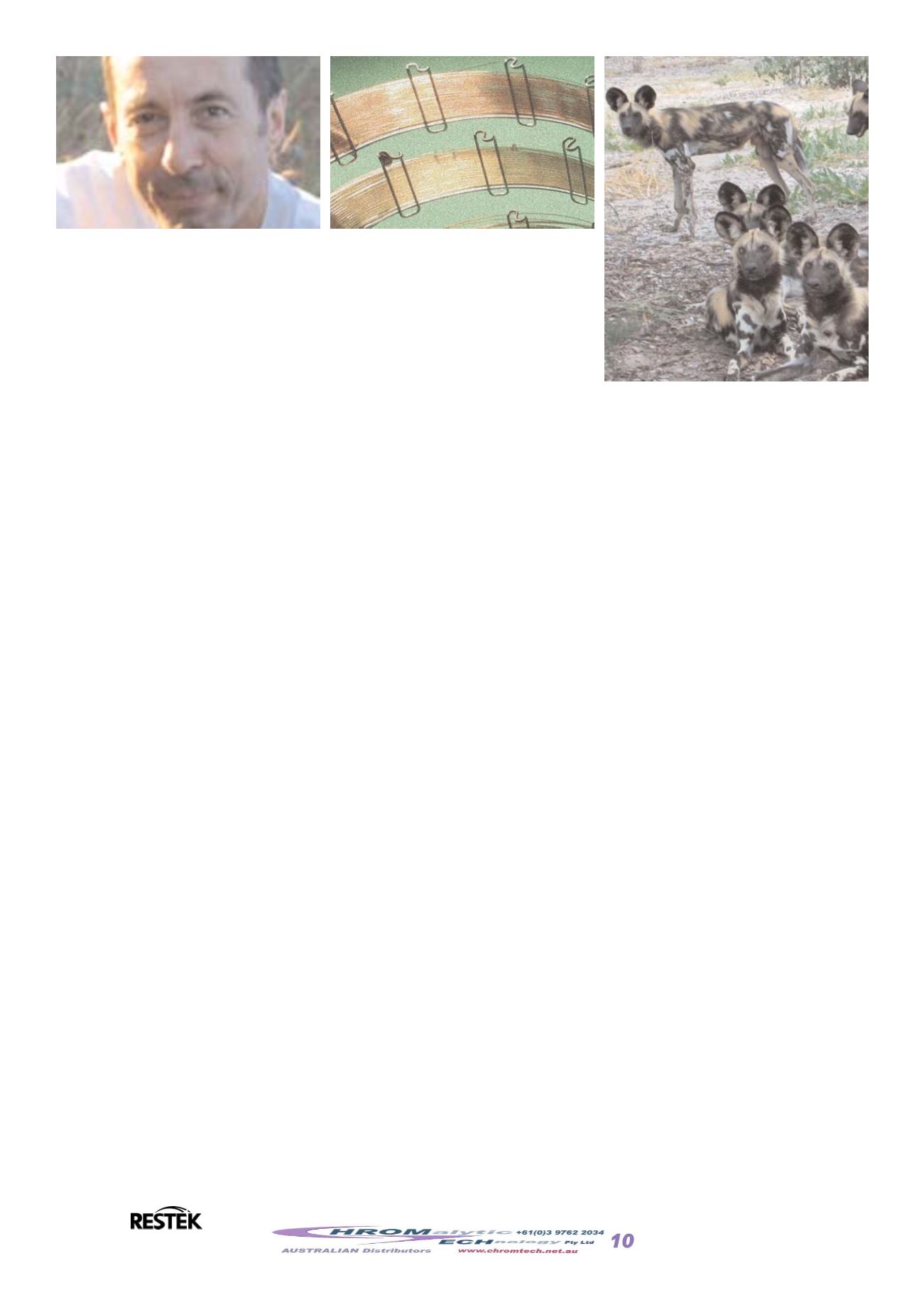

Unraveling Scent Signals to Protect
African Wild Dogs
Peter Apps, Ph.D, Botswana Predator Conservation Trust
Although chromatography’s versatility leads to its application to
a host of diverse problems, helping to protect endangered
African wild dogs from conflicts with people is perhaps not one
that you would expect. With a grant from the Paul G. Allen
Family Foundation, the Botswana Predator Conservation Trust
(BPCT) has established a GC/MS laboratory to identify the chemi-
cal signals that African wild dogs use to mark their territory
boundaries. The ultimate aim is to use artificial scent marks as
“BioBoundaries” to limit movements by wild dogs into areas
where they come into conflict with people and their livestock.
The BPCT BioBoundary project is led by Dr. John “Tico McNutt,”
who has been studying wild dogs since 1989, on the fringe of the Moremi Game Reserve
and the Okavango Delta in northern Botswana. The GC/MS laboratory is located in the vil-
lage of Maun, just 65 km from the BPCT study area, so that it can keep in close contact
with field operations.
African wild dogs
(Lycaon pictus)
are intensely social predators. They live in packs of up to
27 adults and yearlings, in which usually only one pair breeds but everyone cares diligent-
ly for the pups. Numbering less than 6,000, they are one of Africa’s most endangered carni-
vores, and their habitats are increasingly threatened by the expansion of human activities.
Because wild dog packs have huge territories, only the very largest of protected wildlife
areas can sustain viable populations. In Africa, wildlife areas with free-ranging carnivores
are often separated from people and their livestock by only a line on a map or fences that
are easily penetrated. Predators in livestock areas threaten peoples’ livelihoods and the
dogs’ usual fate is to be shot, snared, or poisoned. The aim of the BPCT BioBoundaries proj-
ect is to deploy artificial territorial scent marks, formulated with chemicals identified in nat-
ural wild dog marks, along protected area boundaries to create “virtual” neighboring packs
that will deter dogs from crossing into areas where they are at risk. The stakes are high—
population models predict that wild dogs will be extinct in the wild in 50 years, unless new
ways are found to protect them.
Wild dogs, like nearly all mammals, live in a world dominated by odors. Airborne chemical
signals, known as semiochemicals, play critical roles in their sexual and social behavior. The
pack’s dominant pair assiduously overmark each others feces and urine, and these double
marks stake out the pack’s territory.
Chemically, mammal scents are bafflingly complex, with the active messenger compounds
at trace levels among hundreds of other components. Quantities of active compounds
range down to picograms and concentrations of 10
-18
molar. Nonetheless, mammal
chemical signals are within range of gas chromatography and mass spectrometry, as long
as the technology is used to its full potential. Maximum resolution and reproducibility
Innovators in Chromatography
A continuing series of guest editorials contributed by
collaborators and internationally recognized leaders in
chromatography.
Peter Apps
runs the BPCT Paul G. Allen Family Foundation
Wildlife Chemistry Laboratory in Maun, northern Botswana.
He is a zoologist with a long career in chromatography, a rare
combination that led him back to his zoological roots to set
up the laboratory in July 2008.
18
www.restek.comWebsite :
www.chromtech.net.auE-mail :
info@chromtech.net.auTelNo : 03 9762 2034 . . . in AUSTRALIA











